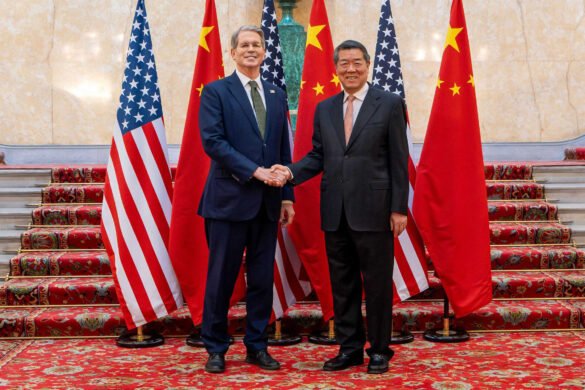U.S. and China Meet in Stockholm to Ease Trade Tensions
STOCKHOLM, July 28 — Senior officials from the United States and China are resuming key trade negotiations in Stockholm to address deep-rooted economic disputes. Their goal: to extend the current tariff truce by 90 days and avoid another round of disruptive tariff hikes between the world’s two largest economies.
The high-stakes meeting is being held at Rosenbad, the Swedish Prime Minister’s office. U.S. and Chinese flags were seen flying outside the venue, signaling a renewed effort to stabilize global trade.
Deadline Approaching: August 12 in Focus
China faces an August 12 deadline to finalize a long-term tariff agreement with the U.S. Without it, harsh triple-digit U.S. tariffs may return, threatening supply chains worldwide. A repeat of the earlier rare earth mineral restrictions and U.S. chip export blocks could be devastating for industries on both sides.
No Major Breakthrough Expected — Yet
Unlike the recent U.S.-EU trade deal with a 15% tariff cap, a quick solution between Washington and Beijing is unlikely. However, trade analysts expect a 90-day extension of the existing tariff freeze, originally agreed upon in May. This pause would help maintain momentum and set the stage for a potential summit between President Donald Trump and President Xi Jinping in late October or early November.
Trump: “We’re Very Close to a Deal”
President Trump hinted on Sunday that talks with China are progressing. “We’ve sort of made a deal,” he told reporters, while emphasizing that the final outcome remains uncertain. Behind the scenes, U.S. officials are reportedly pausing aggressive tech export controls to avoid derailing negotiations.
According to sources cited by The Financial Times, the U.S. Commerce Department has temporarily scaled back curbs on tech exports, aiming to create space for a more productive dialogue.
Focus Areas: Semiconductors, Pharmaceuticals, Cranes
The U.S. is preparing to impose new sector-specific tariffs targeting semiconductors, pharmaceuticals, and industrial equipment like ship-to-shore cranes. If implemented, these could hit China’s export-driven economy hard and inflame tensions further.
So far, discussions have avoided deeper issues such as China’s state-led economic model and U.S. national security controls. However, both countries acknowledge these as long-term sticking points.
Rare Earth Minerals: China’s Key Bargaining Chip
China continues to hold leverage through its dominance in the rare earth minerals market. These resources are essential for electronics, green technology, and even military hardware. Restrictions on these exports have caused concern among U.S. industries relying on Chinese supplies.
Expert Insight: Truce Likely, Full Deal Later
Scott Kennedy, a trade expert at the Center for Strategic and International Studies, believes a full agreement is unlikely in the near term. “A 90-day extension is the most realistic outcome,” he said, noting that previous talks in Geneva and London focused more on repairing the relationship than solving the core disagreements.
Agriculture and Tech Still on the Table
The U.S. wants China to shift its economy away from exports and increase domestic consumption, a long-standing American goal. In return, Beijing may seek reduced tariffs on goods including fentanyl-related items and greater access to high-tech imports.
China has also indicated willingness to increase imports of U.S. farm products, fulfilling pledges made in 2020. But to make that happen, they want the U.S. to reduce multi-layered tariffs currently totaling up to 55% on Chinese goods.
Trump-Xi Meeting Could Define Next Steps
Speculation is growing around a potential Trump-Xi summit in October, possibly in China. Trump has hinted that he will soon decide on making the landmark visit. Analysts say that a successful summit could lead to more relaxed trade rules and a major diplomatic win for both sides.
Sun Chenghao of Tsinghua University said, “A meeting between Trump and Xi would be very beneficial for progress. It gives both sides political space to make real concessions.”
Summary: What’s at Stake in Stockholm
- 90-day extension of tariff truce likely
- Avoiding new U.S. tariffs on semiconductors and pharmaceuticals
- Efforts to restart rare earth trade and tech exports
- Setting the stage for a Trump-Xi summit in October
- U.S. urging China to shift toward domestic consumption
- China seeking rollback of 55% tariff layers and more tech access
Conclusion:
The U.S.-China trade talks in Sweden are a critical moment for global markets. While a final deal is still out of reach, extending the truce would prevent escalation, protect supply chains, and keep hopes alive for a broader economic agreement. As both sides weigh political and economic pressures, the world watches closely.


